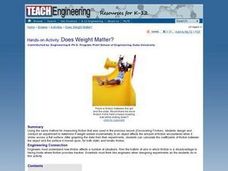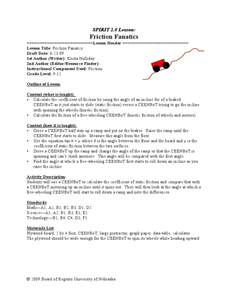Curated OER
Sliders - Static and Kinetic Friction
Middle schoolers work in groups to conduct experiments the demonstrate the differences between static and kinetic friction. They consider how friction affects us in our everyday lives, determine the effects of weight on friction and...
Curated OER
TE Lesson: Factors Affecting Friction
Students investigate the effect of weight on normal friction or the friction due to surface roughness. They tell about the effects of contact area that occurs as a result of molecular attraction by looking at data on line graphs.
Curated OER
Discovering Friction
Learners watch a demonstration that introduces them to the idea that friction is a force that impedes motion when two surfaces are in contact. They work in groups to experiment with frictional force using a coffee cup on which they alter...
Curated OER
Introduction to Friction
Students study the properties of the frictional force between two surfaces in contact. They inspect various phenomena in nature where friction plays an important role and demonstrate
Curated OER
E3 Ret Lesson Plan
Learners explore friction. In this physics lesson plan, students will cover metal blocks with film to determine the changes caused by static and kinetic friction.
Curated OER
Coefficient of Kinetic Friction and Surface Area
Young scholars investigate coefficient of friction with respect to surface area and applied force in contact with the sliding force.
Curated OER
TE Activity: Does Weight Matter?
Students design and conduct experiment to determine if weight added incrementally to an object affects amount of friction encountered when it slides across a flat surface. They graph data from their experiments, and calculate...
Curated OER
Friction Fanatics
Student and compare the three types of friction. For this physics lesson, students determine the coefficient of friction using the CEENBoT. They investigate how friction changes as the angle of the incline changes.
Curated OER
What's the Rub? It's All About Friction!
Learners determine the coefficient of friction for different surfaces. In this physics lesson, students identify the factors that affect friction. They collect data and write a formal lab report.
Curated OER
What a Drag
Middle schoolers learn examples of friction and drag, and suggest ways to reduce the impact of these forces. The equation that governs common frictional forces is introduced, and during a hands-on activity, students experimentally...
Curated OER
Sliding and Stuttering
Students measure frictional force existing between a moving cup and the surface it slides on. They conduct the experiment and answer discussion questions.
Curated OER
Newton's Laws of Motion
Students investigate the effect of thin films to surface friction. In this physics lesson, students calculate the coefficient of friction using mathematical formulas. They discuss its importance in their everyday lives.
Curated OER
Bobsled Challange
Young scholars investigate the effects of materials on the friction between a "bobsled" and the track. They explore the effects of weight on the motion of the bobsled. Students design a bobsled for either fast or slow movement. They...
Curated OER
Sliding and Stuttering
Ninth graders use a spring scale to drag an object such as a ceramic coffee cup along a table top or the floor. The spring scale allows them to measure the frictional force that exists between the moving cup and the surface it slides on....
Curated OER
Circle of Pong
Young scholars, in groups, use given materials to devise a way to deposit a ping-pong ball into a paper cup that is located in the middle of a 6-foot diameter circle, while standing outside the circle.
















